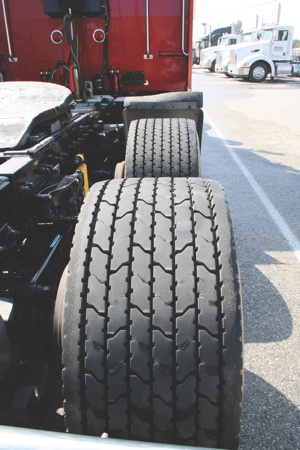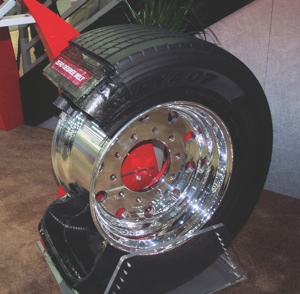 Persuading fleet operators to see the value of super wide truck tires shouldn’t be difficult, despite perceived concerns.
Persuading fleet operators to see the value of super wide truck tires shouldn’t be difficult, despite perceived concerns.
"In the transportation industry, time is money," says Brian Buckham, commercial brand manager for Goodyear Tire & Rubber Co. commercial tire systems. "Fleet owners and managers are always looking for ways to drive down operating costs. If you can convince them that your product will save them time and money, you will receive serious consideration."
Nevertheless, concerns do persist.
"Let’s say you’re hauling a critical load down a deserted highway in the middle of the night," Buckham says.
"You’re many miles away from any truck stop or service center. One of your truck’s super wide tires runs over a nail or another object and abruptly loses air. Continuing to drive is not a viable option since this will damage the expensive wheel on which the now-deflated tire is mounted. Without limp-home capability, you find yourself stranded on the side of the highway, suddenly behind schedule and waiting for assistance. No driver wants to be in this position."
Tom Fanning, director of commercial tire sales for Continental Tire the Americaa, agrees that customers perceive concerns with super-wide tires. "Especially with regard to catastrophic air loss or blowouts, in a high percentage of these cases the tire goes completely flat and the wheel makes contact to the road," says Fanning. "Now, instead of just a new super-single, you also need a replacement wheel, which is a significant expense."
Such issues, in addition to concerns about super wide retreadability and casing life, have made sales of super wides somewhat challenging.
Yet tire manufacturers increasingly are pitching and improving super wides in ways that make the tire’s perks potentially outweigh its pitfalls.
There are two main advantages to super wide tires – weight savings and fuel efficiency, according to Rick Phillips, senior director of commercial and OTR sales at Yokohama Tire Corp.
“An average tractor-trailer outfitted with super wides, versus one outfitted with standard duals, is about 800 pounds lighter. That could represent a huge financial benefit for the fleet to be able to carry the extra payload,” says Phillips.
"And super wide tires typically have a lower rolling-resistance coefficient, meaning a vehicle will burn less fuel to overcome rolling resistance from the tires," he adds.
Fanning says from his standpoint some of the challenges in pitching super wide tires have worn off.
"To convince a fleet of the benefits of gaining several hundred pounds in payload, especially for liquid bulk haulers, and to put that additional capacity into terms of additional profit, is not a terrible challenge,” he says. “In terms of selling for pure fuel efficiency, there still are many duals that can outperform super wides because of advances in compounding and other engineering factors. So, depending on the fleet’s fuel-savings program, that may be more of a challenge.
"But if you can sell super wides into the right segment," he adds, "which, again, in our experience is the liquid bulk haulers in that hybrid application with some long-haul and some regional, then the tires can actually pay for themselves."
A Wide Reach
Super wides, as we understand them today, started life as a tire alternative for city buses in Europe and Asia. Michelin North America commercialized the concept in North America with the introduction of its X One in 2000. Ten years later, MNA sold its one millionth X One, and has since grown the line to include a variety of drive and trail axle models as well as super wide tread stock for retreading.
Bridgestone had a well-accepted super wide being sold for bus applications in Japan and Europe, but was slow to join the North American trucking market with its line-up. Same with all those makers that now offer super wides on this continent.
Being later to the game, though, hasn’t necessarily been a bad thing. Numbers from Goodyear and Yokohama, for example, show super wides as having between 3% and 8% of the fleet marketshare.
However, Phillips notes that, "after very aggressive initial growth, the segment has leveled off a bit and the products have found their niche in the market and in applications where they work well. In the long-term, technology will improve, and that will allow the segment to expand as it finds its way into more applications where it works, and where it can reduce fleet costs."
Many technology improvements already exist. Continental, for example, in October introduced ContiTread retreads, which are expected to match the performance of the company’s HTL1 super wide trailer tires in several widths.
Besides, Fanning says, "retreadability of super wides is a concern, but not because of the design of the tire. In our experience, the behind-the-scenes reason for retreading issues is that the maintenance pro- grams of fleets are specified to pull tires at what may be a very reasonable tread depth for duals, but too low for super wides because of their tendency for shoulder wear.
"From our perspective, there are no differences in retreading super wides versus duals," he adds. "Continental’s approach is to achieve seamless matching between new tires and retreads so we use the same tread patterns, depths and compounding as with new tires.”
Continental also advises the use of TPMS, like its ContiPressureCheck, with any super wide. "By using a tire-pressure monitoring system," Fanning says, "catastrophic damages are mitigated or avoided with an early warning on creeping air loss, which is the real cause of most blowout scenarios."
Meanwhile, Goodyear introduced two super wide tires two years ago that feature the company’s DuraSeal Technology. It instantly self-seals nail-hole punctures up to a quarter-inch in diameter and is highlighted in bright yellow for easy puncture detection.
"When a super wide truck tire goes flat, it can completely immobilize a truck, which leads to costly downtime," Buckham reminds.
Goodyear also has implemented the use of new compounds and specialized tread designs in its Fuel Max super wides, resulting in lower rolling resistance and reduced fuel consumption. And its patented UniCircle retread, featuring a continuous ring of seamless construction matching the casing shape, also has been introduced to its super wide retread line, helping to extend casing life and tire mileage while maintaining low resistance and fuel costs.
"There are more and more products out there, and the offerings are growing," Phillips says. "It’s really not any different than any other tire product. It’s important to look beyond just the original tread and consider the overall quality of the casing and the ability to be retreaded and put back into service, which extends service life and provides a greater return on the investment."
A Wide Variety
So, what do dealers need to know about carrying super wide tires?
While mounting the larger tires can be more challenging, it doesn’t require different equipment, according to Buckham.
"The only thing that comes to mind is that there are different drop bars used for mounting super wides as opposed to duals," Fanning adds. "But training is an investment that would need to be made to ensure that service technicians are aware of safety practices as well as the need to torque every wheel fastener to specification."
"Making sure technicians are properly trained on how to service and maintain is more important than the equipment used," Phillips agrees.
Phillips also advises dealers that the number of SKUs needed "will vary from region to region based on the fleets in an individual area, but in any case a minimal amount of SKUs can adequately service most markets."
As for each company’s most popular products, the spokesmen have various offerings:
• Yokohama has its TY517 drive tire and the RY407 trailer tire, featuring weight and fuel savings expected from UWB products along with exceptional retreadability.
• Continental offers its HDL2 Eco Plus tire, implementing an evolving sipe tread design and closed shoulder with a 27/32-inch tread depth, as well as its HTL1 super wide, with advanced stone bumpers and a shoulder defense groove in its 13/32-inch tread depth.
• Goodyear highlights its aforementioned G392 SSD DuraSeal Plus Fuel Max and G394 DuraSeal Plus Fuel Max, both available in size 445/50R22.5, Load Range L.
Finally, Phillips recommends that dealers honestly assess the super wide market.
"Fleets are always looking to reduce operating costs, so they usually are open to solutions that could possibly save them money," he says. "But if there is a challenge, it’s to recognize that, for various reasons, these products will not work for every fleet in every application – and not to try to force it into those places."













